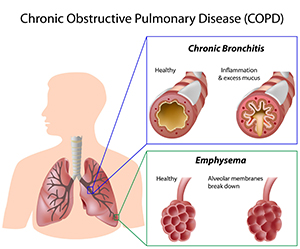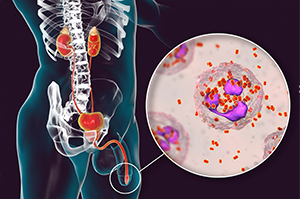WHAT IS CHRONIC OBSTRUCTIVE PULMONARY DISEASE (COPD)?
 Chronic obstructive pulmonary disease (COPD) is a group of progressive lung diseases that make it difficult to breath. The two most common are emphysema and chronic bronchitis; many people with COPD have both of these conditions. Emphysema destroys the lung’s air sacs, which cause breathlessness. Chronic bronchitis is the inflammation of the lining of bronchial tubes, which carry air to and from the lungs.
Chronic obstructive pulmonary disease (COPD) is a group of progressive lung diseases that make it difficult to breath. The two most common are emphysema and chronic bronchitis; many people with COPD have both of these conditions. Emphysema destroys the lung’s air sacs, which cause breathlessness. Chronic bronchitis is the inflammation of the lining of bronchial tubes, which carry air to and from the lungs.
The top cause of COPD is tobacco smoking. Prolonged exposure to chemical irritants, air pollution or secondhand smoke can also lead to COPD. Genetics can also play a role. The rare genetic disorder, Alpha-1 Antitrypsin Deficiency, is the cause of approximately one to five percent of COPD cases. The inherited condition affects the body’s ability to produce the Alpah-1 protein, which protects the lungs.
COPD is a disease that takes a long time to develop. Typically, most patients are at least 40 years old when COPD symptoms begin to appear. Patients with COPD experience chronic cough, shortness of breath, blueness of lips or fingernails, fatigue and wheezing. Many people wrongly mistake these symptoms as just a part of getting older. Detecting these symptoms early could mean an improved prognosis and quality of life. Other complications from COPD include respiratory infections, heart problems, lung cancer, high blood pressure and depression.
COPD cannot be cured, but it can be effectively treated. For some mild cases, smoking cessation may be the only step in one’s treatment plan. There are medications like bronchodilators, inhaled steroids, combination inhalers, oral steroids, theophylline and antibiotics to treat symptoms and complications. For patients with moderate to severe COPD, lung therapy may be used. There are oxygen therapies and pulmonary rehabilitation programs.
There are lifestyle and home remedies patients with COPD can try. Control your breathing techniques, so you are more efficient throughout the day. Clear your airways from collected mucus by controlled coughing, drinking plenty or water, or using a humidifier. Try to exercise regularly to strengthen your respiratory muscles and eat healthy foods to lose or maintain weight. Most importantly, avoid smoke and air pollution, and see your physician regularly.
More than 12 million Americans are living with a COPD diagnosis. Another 12 million are estimated to have COPD without knowing it. COPD claims more that 120,000 American lives each year. In the U.S. women are 37 percent more likely to have COPD than men. People with symptoms at risk for COPD should discuss concerns with their doctor. Contact Dr. Masood at Piedmont Internal Medicine, Pulmonary and Infectious Diseases at (919) 787-9993 or visit www.PiedmontIMIDLungAndSleep.com.
Sources:
Healthline.com
Lung.org
Mayo Clinic
Gonorrhea/Syphilis Statistics and Facts
 Gonorrhea is an infection caused by a sexually transmitted bacterium that can infect both males and females. In the U.S., 550,608 cases of gonorrhea were reported in 2017. The rate of reported gonorrhea hit a historic low in 2009 at 18.6 percent. However, during 2016-2017, the U.S. saw a dramatic spike in reported cases to 75.2 percent. Gonorrhea is a very common disease, especially among people ages 15-24.
Gonorrhea is an infection caused by a sexually transmitted bacterium that can infect both males and females. In the U.S., 550,608 cases of gonorrhea were reported in 2017. The rate of reported gonorrhea hit a historic low in 2009 at 18.6 percent. However, during 2016-2017, the U.S. saw a dramatic spike in reported cases to 75.2 percent. Gonorrhea is a very common disease, especially among people ages 15-24.
Signs and symptoms of gonorrhea in men include painful urination, discharge and pain or swelling in one testicle. In women, signs and symptoms consist of increased vaginal discharge, painful urination, painful intercourse and abdominal or pelvic pain. Gonorrhea infection can also affect the rectum, eyes, throat or joints.
To determine whether gonorrhea bacterium is present in your body, your doctor will swab the affected area or administer a urine test to analyze a sample of cells. Adults with gonorrhea are treated with antibiotics. Even if your partner shows no signs or symptoms, he or she should undergo testing and treatment. If left untreated, gonorrhea can lead to infertility in both men and women, widespread infection to the joints, increased risk of HIV/AIDS or complications in newborns.
Syphilis is a bacterial infection commonly spread by sexual contact. The disease starts with a sore that can quickly spread from person to person through skin or mucous membrane contact. There are four stages of syphilis: primary, secondary, latent and tertiary. After the initial infection, the syphilis bacteria can lie dormant in the body for years, which is why some people do not know they have been infected until it becomes active again.
In 2017, a total of 30,644 cases of primary and secondary syphilis were reported in the U.S. This is a 72.7 percent increase compared with 2013. Because syphilis is a “skin-to-skin” disease, it makes it much easier to get and give HIV.
The earlier syphilis is diagnosed, the easier it is to cure. To diagnose syphilis, specialists can perform a blood test or collect a sample of cerebral spinal fluid. The preferred method of treatment is an antibiotic medication, penicillin. After treatment, it is recommended to undergo blood tests periodically to make sure your body has responded to the antibiotic. Avoid sexual contact until the infection has been cured and notify your partners so they can get tested also.
The prevalence of sexually transmitted infections continues to increase across the U.S. Experts think the rise can be attributed by the use of online dating apps among the younger generations. If you are sexually active, always use protection and talk to your partner about his or her status before engaging in intercourse.
Sources:
Mayoclinic.com
Mayoclinic.com
CDC.gov
Understand More About Smoking Related Breathing Issues
 It is no secret that smoking cigarettes comes with a multitude of health issues and risk of diseases. In fact, more people die from lung cancer than any other type of cancer. The inhalation of cigarette smoke prevents your breathing tubes to clear secretions. Smokers have decreased immunity, because of the aging of their immune system due to inflammation which makes them more prone to respiratory infections. Effects on the respiratory system from long term smoking include:
It is no secret that smoking cigarettes comes with a multitude of health issues and risk of diseases. In fact, more people die from lung cancer than any other type of cancer. The inhalation of cigarette smoke prevents your breathing tubes to clear secretions. Smokers have decreased immunity, because of the aging of their immune system due to inflammation which makes them more prone to respiratory infections. Effects on the respiratory system from long term smoking include:
More than half a million living Americans have been diagnosed with lung cancer in their lives. Smoking is one of the main causes for small cell and non-small cell cancer, which contributes to 80 percent of lung cancer deaths in men and 90 percent of lung cancer deaths in women. People with high risk for lung cancer are recommended to receive annual screenings. With early screening, lung cancer survival rates are improving by finding the disease at an earlier stage when it is more likely to be curable.
Emphysema is a disease that destroys alveoli, which are air sacs in the lungs. When the air sacs weaken and eventually break, the surface area of the lungs reduces as does the amount of oxygen that reaches the blood stream. This makes it harder to breathe, especially when exercising. Other symptoms of emphysema include exhaustion, weight loss, depression or fast heartbeat. Smokers are more likely to develop chronic bronchitis due to the repeated irritation and damage to lung and airway tissue. Symptoms of bronchitis include persistent cough, wheezing, chest tightening and body aches.
If chronic bronchitis occurs with emphysema, it may become COPD. With COPD, less air flows through the airways which causes blockage and makes it difficult to breathe. In the early stages, symptoms may be mild like a nagging cough, wheezing and tightness in the chest. As the disease gets worse, symptoms could include difficulty catching your breath or talking, elevated heartbeat, swelling in the feet and ankles and trouble with mental alertness. Other treatments include special diet, exercise training, medication, oxygen therapy or surgery.
Long time smokers will experience damage and irritation to their windpipe and voice box. This makes it hard to breathe and hard to speak. Smokers may also experience reduced lung function and breathlessness. When inhaling toxins from cigarette smoke, lungs are unable to remain clear, which leads to the build-up of poisonous substances.
The best way to lessen the risk of respiratory disease is to quit smoking and to avoid secondhand smoke. Make an appointment with us today if you are interested in Pulmonary Function Tests (PFTs) or Bronchoscopies. PFTs are a group of tests that measure how well lungs take in and release air, and how well they move oxygen into the blood. Bronchoscopy is a test to view the airways and diagnose lung disease. To learn more, visit our website www.PiedmontIMIDLungAndSleep.com or call 919-787-9993.
Sources:
Healthline.com
CDC.gov
Lung.org